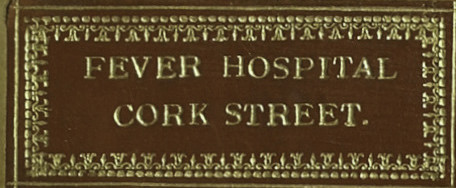The figures for the following decade indicate that fever continued to persist and admissions figures were even higher.
1821 2994
1822 2996
1823 2300
1824 2668
1825 4679
1826 4353
1827 10612
1828 6500
1829 2932
1830 3170
The total number of admissions was 43,204. Again there is no breakdown of these figures but it was a decade where famine reared its head and a decade where an economic policy decision had an unintended consequence. Writing in The Lancet in 1826 Corrigan described the onset of fever in 1826 as sudden and its spread as alarming. Once again its cause was put down to the failure of the potato crop of 1825. In Dublin, 20, 000 weavers lost their employment, ‘though a sudden reverse of trade.’ It commenced among the poor, stayed with them and spared the rich. (Dr. Dominic Corrigan, On the epidemic of fever in Ireland, The Lancet, 3rd april 1830 pp570-574) Typhus fever, yellow fever and typhoid were all reported as being prevalent and its cause was attributed to the financial situation the weavers found themselves in. The sudden reverse of trade as Corrigan put it, was caused by a unique set of events based around economic thinking in that period. There was demand for free trade between Ireland and the United Kingdom in the 1820’s which culminated in 1826 with an unexpected reduction in tariff’s between the two countries. At the same time, transport costs declined with the arrival of steam boat services. The cotton industry in Dublin had thrived under the umbrella of protectionism and work agreements with labour unions had led to higher wages. There were restrictions around the introduction of new technology and rules around apprenticeships which employers claimed were already causing factory closures prior to the reduction in tariffs. The decision to create a customs and currency union led to the collapse of the cotton and loom industry in Dublin. (David Dickson, Dublin and the Union in Peter Clarke and Raymond Gillespie (eds) Two capitals London and Dublin 1500-1840 (New York, 2001) p128 71) In the silk trade, 1,860 looms which once employed 6,280 people were now idle, 850 woollen looms which had given employment to 11,110 people and 443 cotton looms which employed 3,960 were all forced to close when lower priced goods from England flooded the market.( The Irish Quarterly Review, Vol iv, (Dublin 1854) p654 )Many of the weavers emigrated to find work. Those who remained were offered public work breaking stones. The hospital minutes refer to the abolition of the Irish pound and its replacement by the English pound in 1826. Arthur Guinness, hospital trustee, in his role as Governor and director of the Bank of Ireland was actively involved in the preparations for the introduction of the English currency. The extent of the fever epidemic in Dublin led to tents being erected in the hospital grounds which were capable of holding 180 beds. In the city itself 1400 beds
were estimated to be available specifically to deal with the outbreak.(Charles Creighton, A history of epidemics in Britain, (Cambridge,1891) P272) Many of these beds were also in tents situated in the grounds of various hospitals. The Cork Street tents remained in place until June 1827. In a letter to the hospital board in June 1826, Dr. Stoker drew attention to the many issues linked to the various outbreaks of fever in the city. In relation to 1826 he decried the lack of employment caused by the introduction of machinery which, on one hand, reduced the need for manual labour, and on the other encouraged an influx of workers experienced in the use of the new equipment. (Hospital Minutes, 24th June 1826 p241) In the same month another hospital physician, Dr. Grattan, also writing to the board expressed his belief that in order to arrest the spread of fever a fairer proportion of the necessities of life fuel, clothing and shelter, must be equally available to the honest labourer and mechanic as they are to the wealthy. Grattan went on to wonder how this could possibly be achieved in the present state of society in Ireland ‘deserted as we are by our nobility and landed proprietors who drain the country of its last guinea.’ (Hospital Minutes, 24th June 1826, p246) Grattan specifically mentioned the plight of the starving weavers who were obliged to substitute the spade and the shovel for the shuttle, who were employed in any work and no work in digging holes and filling them again for the mere purpose of employing him, no matter how useless such work may be. Grattan finished his lengthy letter by questioning the logic of providing more funds to fight fever when money would be better spent providing employment for the poor, and adopt measures to promote ventilation and enforce cleanliness which would lead to a decrease in contagion.
fever 1826 Newspaper article
